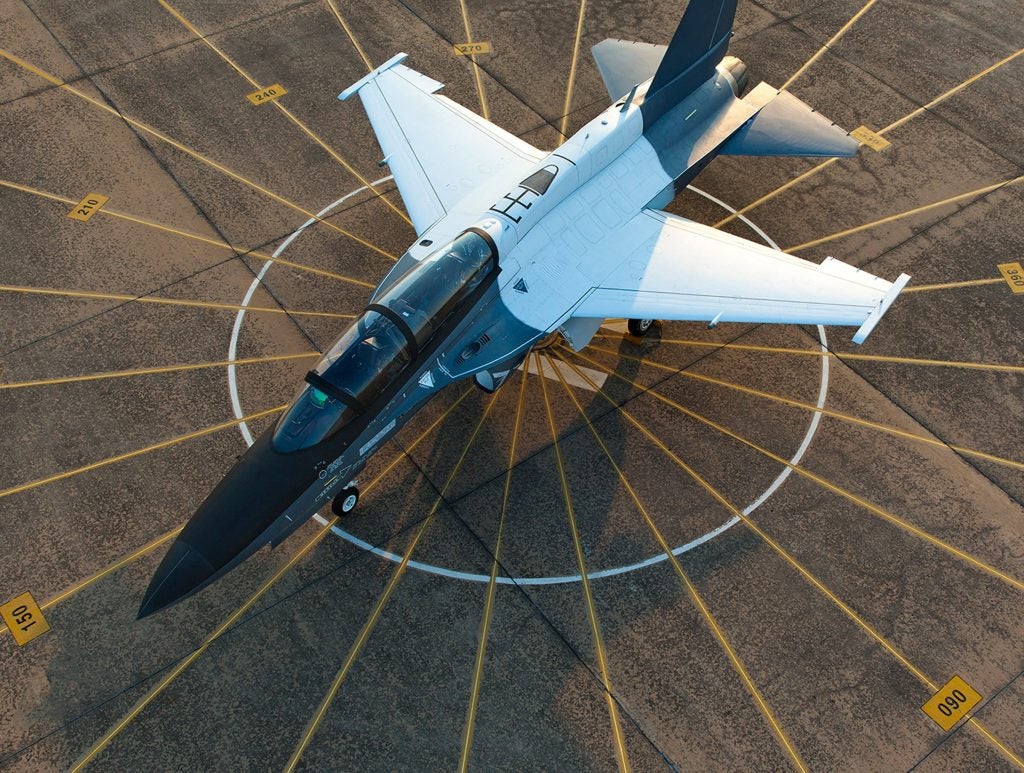Red 6's Advanced Tactical Augmented Reality System (ATARS) will be integrated into the T-50 platform and related ground-based training systems, according to a statement released 20 June by Lockheed Martin, Korea Aerospace Industries, and Red 6.
This news falls on the same day that Red 6 announced a strategic agreement the the UK’s Royal Air Force and National Security Strategic Investment Fund to supply augmented reality technologies in support of the UK military flight training ecosystem.
According to Red 6's founder and CEO, Daniel Robinson, a training environment that allows for the combination of virtual assets visually represented in the real outdoor world has never existed until now, and that in the US alone the technology should be able to train an additional 200 pilots a year, representing a significant step towards eliminating the roughly 2,000 frontline pilot shortfall the US is currently experiencing.
Red 6 achieve this by providing an augmented reality experience for fighter pilots flying real jets through the skies. Using a visor that overlay targets on the pilot’s broad field of vision as the they fight against the real forces of momentum, acceleration, and gravity. Such technology enables pilots to enter secure, realistic, and scalable training environments while in the air, even in the most challenging outdoor conditions.
Training better pilots with less investment
The augmented reality approach preserves the experience of combat, carrying the cognitive load of managing an aircraft its and innate dangers, while striving to best an opponent, but it does so at half the cost and environmental damage of normal training, and ultimately produces better pilots.
Pilots trained using augmented reality compete against the same skilled flight personnel, but Red 6 have opened up the capacity to engage in scenarios where there are so many opponents that it would be prohibitively expensive to train against, and train in problem sets where the opponents have capabilities and profiles that match the most sophisticated airframes modern peer-adversaries possess.
“The way we traditionally do training is every time I go up to fly and train I need someone to go fly and train against,” said Robinson in a recent interview.
This has inherent limitations: pilots exercises occur in a threat environment with a limited number of opponent aircraft; the classes of enemy aircrafts in training do not represent the full range or sophistication of a peer-adversary; and at a cost of $100,000 per hour, per plane, only half of the pilots flying in the air will be benefiting from the blue sky opportunity as part of a ‘good-guy sortie’, while their partners experience negative training, reproducing the behaviour of an adversary.
Hybrid synthetic training before Augmented Reality lacked close affray capabilities
Even before Red 6, there had been live-action synthetic approaches to training that work with pilots are simulating interactions meant to occur over great distances. In these exercises, fighter pilots in simulators on the ground ‘beam up’ the profile of a plane they are operating so that it appears in on the radar displays of training pilots on real planes in the skies. Pilots then conduct their mission in response to the input from their electronic equipment.
A similar approach is constructed synthetic training, where, again, a live pilot is flying in the air in a real jet, but in this case the radar readings the pilot encounters are generated by artificial intelligence. It is possible with these approaches to simulate a large number of sophisticated enemy aircraft.
However, these exercises fail to translate to close range fighter combat. “At ten nautical miles, the role of a fighter pilot changes from three dimensional chess player,” says Robinson, a former RAF Tornado pilot and graduate of the fighter weapon school, who was selected as the first non-American pilot of the F-22 stealth fighter, “to one where I am putting in the proverbial gum-shield for a fist-fight and I’m looking out the window to visually find these guys and kill them quickly.”
"And the moment that happens live-action [or] constructive collapses. And the reason it collapses is as soon as I look out of the window, there's nothing there to see.”
Red 6 substitute simulated radar signals with an augmented reality headset that provides a full colour, wide field of view, high resolution display.
The technical challenges involved with adapting augmented reality to the cockpit are not slight. “Breaking it down, we need to track and understand where the human being is looking and to understand our environment around us. And then we need to be able to generate enough light, and with a wide field of view, and then at sufficiently low latency to draw in a compelling way.”
How far along is Red 6 to achieving this? “We’ve done it,” replied Robinson.

New horizons in the military metaverse
With the addition of the ATARS system, as well as being able to simulate within-visual range dynamic environments, Red 6 are able to render entire landscapes and theatres, bringing a new dimension to training not seen before.
While using augmented reality, pilots flying over open seas can experience a visual display that overlays calm oceans with a geographic image of a specific location, allowing the pilot to look out of the cockpit window and see terrain detailed to the exact specification of what that theatre might be.
While Robinson envisioned Red 6 primarily for use in air, he said that the vision of the company is now to see all domains operating together in a joint augmented reality military metaverse, that has a virtual world and threat environment that is persistent, continuous and synchronised for personnel to go outdoors and train within.
“I think over time, as augmented reality matures…, you will see a shift from a virtual reality bias to an augmented reality bias, and virtual reality will be considered a subset of mixed reality, augmented reality, over time.”
“Augmented reality is the gateway to the metaverse, because the definition, as far as I can tell, of the metaverse is a ubiquitous layer of data and metadata that is overlaid on top of the real world that goes with us wherever we are.”
With a military set up to use ATARS persistently, personnel will in theory be empowered to use dead-time to train. As an example, Robinson describes mid-air refuelling as a technical manoeuvre that can be rehearsed on-the-go by pilots on their way to their air space.
Lockheed Martin adapt T-50 demonstrator for use with augmented reality
The T-50 demonstrator and Red 6 ATARS technology have been electronically networked with the Lockheed Martin Prepar3D software simulation suite, and although the ATARS system was initially aimed for introduction to the T-50 programme, has the potential to be utilised in operational Lockheed Martin platforms like the F-16, F-22, and F-35 in the future.
The T-50, which continues to be in high demand globally, according to Aimee Burnett, vice president of business development for the Integrated Fighter Group at Lockheed Martin, is built to serve three near-term missions, which include tactical training, adversary air support, and tactical fighter surrogate.
The TF-50A has been designed to serve as a versatile light attack fighter/trainer, equipped with advanced features such as radar, electronic warfare system, tactical data link, and other capabilities that meet the requirements of the Air Combat Command.
According to Aimee Burnett, vice president, Business Development for the Integrated Fighter Group at Lockheed Martin, the T-50 programme continues to be in high demand globally. Lockheed Martin has submitted the TF-50A variant to the US Air Force's trainer programme.
The ATARS system, which is initially aimed for introduction to the T-50 programme, has the potential to be utilised in operational Lockheed Martin platforms like the F-16, F-22, and F-35 in the future.
Lockheed Martin has submitted the TF-50N variant for the U.S. Navy's trainer programme. The TF-50N has been specially designed to cater to a variety of missions for the U.S. Navy, which includes pilot landing qualification, adversary air, training chase, and tactical surrogate.









